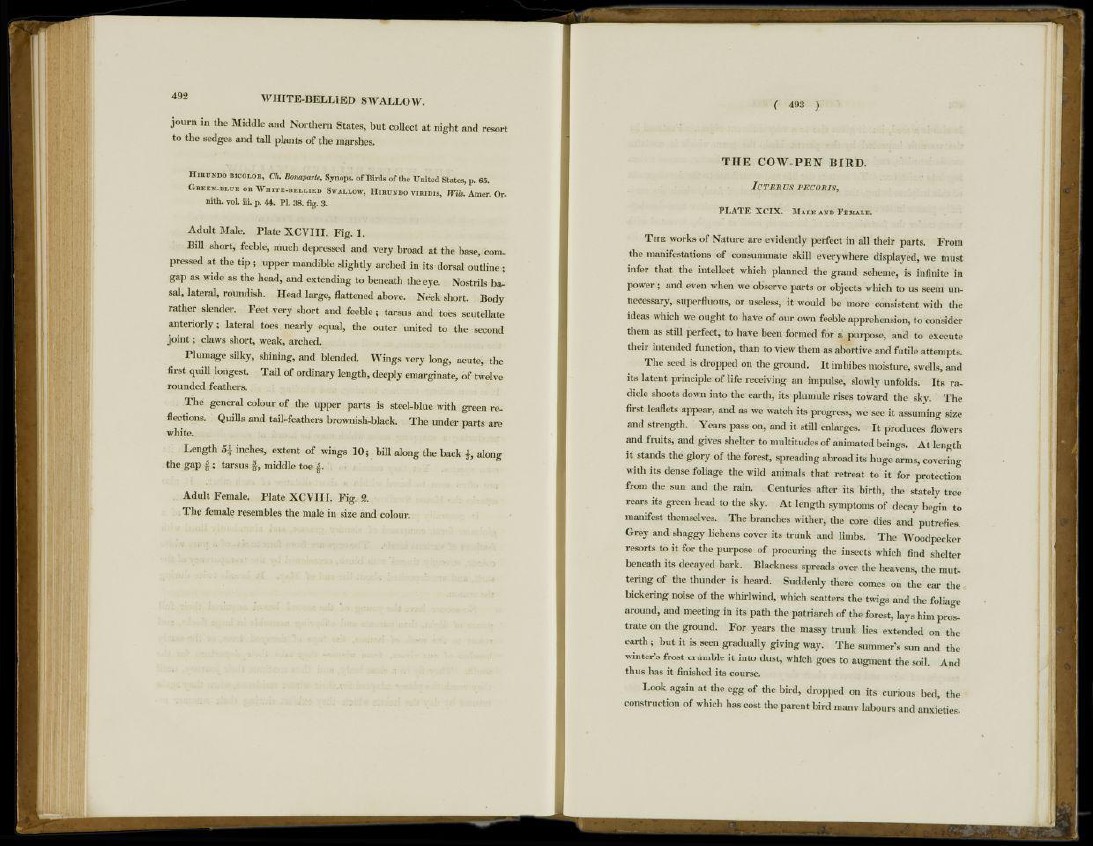
492 WHITE-BELLIED SWALLOW.
journ in the Middle and Northern States, but collect at night and resort
to the sedges and tall plants of the marshes.
HIRUNDO BICOLOR, Ch. Bonaparte, Synops. of Birds of the United States, p. 6 5 .
GREEN-BLUE OR WHITE-BELLIED SWALLOW, HIRUNDO VIRIDIS, Wits. Amer. Ornith.
vol. iii. p. 44. PL 38. fig. 3.
Adult Male. Plate XCVIII. Fig. 1.
Bill short, feeble, much depressed and very broad at the base, compressed
at the tip ; upper mandible slightly arched in its dorsal outline ;
gap as wide as the head, and extending to beneath the eye. Nostrils basal,
lateral, roundish. Head large, flattened above. Neck short. Body
rather slender. Feet very short and feeble; tarsus and toes scutellate
anteriorly ; lateral toes nearly equal, the outer united to the second
joint; claws short, weak, arched.
Plumage silky, shining, and blended. Wings very long, acute, the
first quill longest. Tail of ordinary length, deeply emarginate, of twelve
rounded feathers.
The general colour of the upper parts is steel-blue with green reflections.
Quills and tail-feathers brownish-black. The under parts are
white.
Length 5 £ inches, extent of wings 10; bill along the back i , along
the gap | ; tarsus f, middle toe
Adult Female. Plate XCVIII. Fig. %
The female resembles the male in size and colour.
( 493 )
T H E COW-PEN BIRD.
ICTERUS PECORIS,
P L A T E X C I X . MALE AND FEMALE.
THE works of Nature are evidently perfect in all their parts. From
the manifestations of consummate skill everywhere displayed, we must
infer that the intellect which planned the grand scheme, is infinite in
power ; and even when we observe parts or objects which to us seem unnecessary,
superfluous, or useless, it would be more consistent with the
ideas which we ought to have of our own feeble apprehension, to consider
them as still perfect, to have been formed for a purpose, and to execute
their intended function, than to view them as abortive and futile attempts.
The seed is dropped on the ground. It imbibes moisture, swells, and
its latent principle of life receiving an impulse, slowly unfolds. Its radicle
shoots down into the earth, its plumule rises toward the sky. The
first leaflets appear, and as we watch its progress, we see it assuming size
and strength. Years pass on, and it still enlarges. It produces flowers
and fruits, and gives shelter to multitudes of animated beings. At length
it stands the glory of the forest, spreading abroad its huge arms, covering
with its dense foliage the wild animals that retreat to it for protection
from the sun and the rain. Centuries after its birth, the stately tree
rears its green head to the sky. At length symptoms of decay begin to
manifest themselves. The branches wither, the core dies and putrefies.
Grey and shaggy lichens cover its trunk and limbs. The Woodpecker
resorts to it for the purpose of procuring the insects which find shelter
beneath its decayed bark. Blackness spreads over the heavens, the muttering
of the thunder is heard. Suddenly there comes on the ear the
bickering noise of the whirlwind, which scatters the twigs and the foliage
around, and meeting in its path the patriarch of the forest, lays him prostrate
on the ground. For years the massy trunk lies extended on the
earth ; but it is seen gradually giving way. The summer's sun and the
winter's frost crumble it into dust, which goes to augment the soil. And
thus has it finished its course.
Look again at the egg of the bird, dropped on its curious bed, the
construction of which has cost the parent bird manv labours and anxieties.